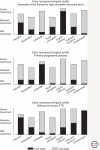The neuropsychological profile of Alzheimer disease
- PMID: 22474609
- PMCID: PMC3312395
- DOI: 10.1101/cshperspect.a006171
The neuropsychological profile of Alzheimer disease
Abstract
Neuropsychological assessment has featured prominently over the past 30 years in the characterization of dementia associated with Alzheimer disease (AD). Clinical neuropsychological methods have identified the earliest, most definitive cognitive and behavioral symptoms of illness, contributing to the identification, staging, and tracking of disease. With increasing public awareness of dementia, disease detection has moved to earlier stages of illness, at a time when deficits are both behaviorally and pathologically selective. For reasons that are not well understood, early AD pathology frequently targets large-scale neuroanatomical networks for episodic memory before other networks that subserve language, attention, executive functions, and visuospatial abilities. This chapter reviews the pathognomonic neuropsychological features of AD dementia and how these differ from "normal," age-related cognitive decline and from other neurodegenerative diseases that cause dementia, including cortical Lewy body disease, frontotemporal lobar degeneration, and cerebrovascular disease.
Figures


References
-
- Albert MS, Blacker D 2006. Mild cognitive impairment and dementia. Annu Rev Clin Psychol 2: 379–388 - PubMed
-
- Albert MS, Dekosky ST, Dickson D, Dubois B, Feldman HH, Fox NC, Gamst A, Holtzman DM, Jagust WJ, Petersen RC, et al. 2011. The diagnosis of mild cognitive impairment due to Alzheimer’s disease: Recommendations from the National Institute on Aging-Alzheimer’s Association workgroups on diagnostic guidelines for Alzheimer’s disease. Alzheimers Dement 7: 270–279 - PMC - PubMed
-
- Aronoff JM, Gonnerman LM, Almor A, Arunachalam S, Kempler D, Andersen ES 2006. Information content versus relational knowledge: Semantic deficits in patients with Alzheimer’s disease. Neuropsychologia 44: 21–35 - PubMed
-
- Backman L, Small BJ, Fratiglioni L 2001. Stability of the preclinical episodic memory deficit in Alzheimer’s disease. Brain 124: 96–102 - PubMed
Publication types
MeSH terms
Grants and funding
LinkOut - more resources
Full Text Sources
Medical
Miscellaneous
